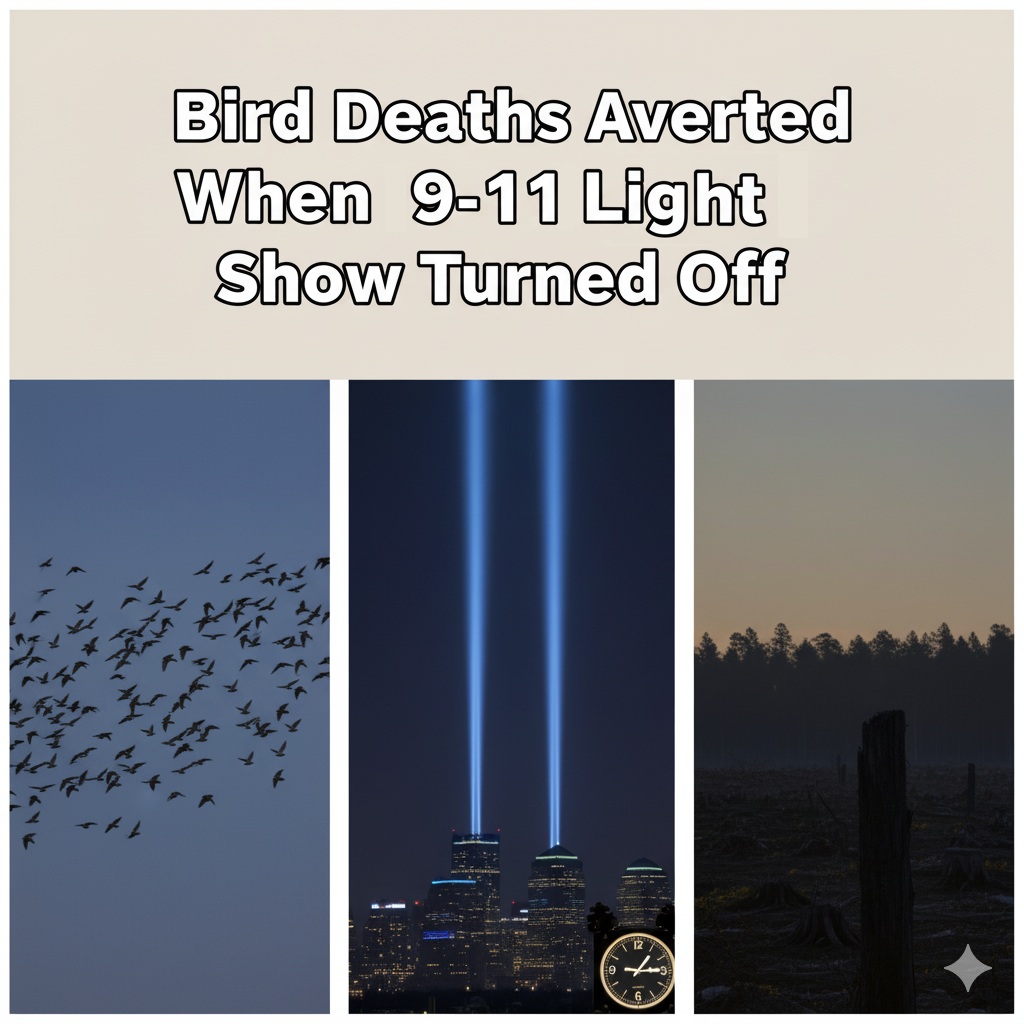
Every year in New York City, a stunning light show called the Tribute in Light honors the victims of the 9/11 attacks. But alongside its beauty lies an unexpected challenge: the powerful beams of light often confuse thousands of migrating birds flying through the city’s skies. Thankfully, recent efforts turning off the lights at crucial moments have helped save hundreds of birds from injury and death, showing how human actions can protect wildlife even during large public events.
The Lights and the Birds
The Tribute in Light shines two massive columns of light over Lower Manhattan where the Twin Towers once stood. These bright beams start at dusk and continue until dawn, visible for miles around. While the display pays a beautiful and solemn tribute, it also unintentionally draws the attention of migratory birds.
Birds migrating southward at night use natural cues like stars, the Earth’s magnetic fields, and landmarks to navigate. However, the glowing beams and city lights can confuse them, causing many to gather in the lights, circling and calling out as they struggle to find their way. Some become trapped or move lower, risking collisions with nearby buildings, which is a deadly problem for urban wildlife.
A Moment of Crisis and Rescue
On the night of September 11-12 in 2013, ornithologists noticed an alarming scene. Thousands of birds were gathered, spiraling lower around the Tribute’s light beams, filling them like a glowing cloud. Their calls grew louder as their confusion increased, making it easy to identify them without binoculars.
Susan Elbin, director of conservation at New York City Audubon, was one of many volunteers stationed on a parking garage roof right by the Tribute. When she saw the disoriented flock growing and birds descending dangerously, she contacted the light show manager, Michael Ahern. Together, they made quick decisions to turn off the lights several times during the night to allow the birds to escape.
Each time the lights went off for about 20 to 30 minutes, the birds would spread out and fly higher, regaining their bearings safely. This action prevented hundreds of bird deaths, demonstrating that simple, real-time responses can save wildlife without compromising the memorial’s respectfulness.
Who Were the Birds?
The species caught in the lights were mainly migratory songbirds passing over New York City during fall migration. These included:
- American Redstart
- Canada Warbler
- Black-throated Blue Warbler
- Swainson’s Thrush
- Wood Thrush
- Rose-breasted Grosbeak
Even a Peregrine Falcon was spotted during the event. These species depend on aerial cues for navigation during their long journeys from breeding grounds in North America to wintering areas in Central and South America.
Why Do Birds Get Confused?
Bright lights trick birds’ natural navigation systems. Instead of flying over the city to avoid danger, birds are attracted to artificial light sources, getting trapped in the beams. This behavior can lead to exhaustion, disorientation, and collisions with buildings. The problem worsens on cloudy or foggy nights when visibility is limited, and birds rely more heavily on light cues.
Research using radar, acoustic monitoring, and direct observation confirmed that bird densities near the Tribute can reach 60 to 150 times above normal levels. This indicates why so many birds get caught in the lights and why immediate action to reduce light is vital.
Bird Migration Prediction and Protection
The BirdCast system, developed by the Cornell Lab of Ornithology and other partners, forecasts bird migration using weather data, radar, and bird sightings. Although BirdCast predicted fewer birds around New York during the Tribute in 2013, unexpected weather events called “gust fronts” stirred up bird movement more than forecasted.
Thanks to this data and close monitoring, volunteers knew to watch carefully and coordinate light shutdowns whenever necessary. BirdCast and similar tools help cities and building managers reduce light pollution during peak migration, potentially saving millions of birds annually across urban areas.
The Bigger Picture: Light Pollution and Bird Deaths
Beyond the Tribute, urban areas like New York cause around 90,000 bird deaths annually because of lights and glass collisions. Across the United States, nearly 600 million birds die each year due to building strikes. Lights draw birds into dangerous areas, making city skylines hazardous for migratory and local birds alike.
Turning off unnecessary lights during migration seasons is a powerful conservation tool. Many cities now work with conservation groups and scientists to create “lights out” programs to protect birds during their flights. These efforts reduce fatalities without impacting human safety or urban life.
The Human Side of Conservation
The Tribute in Light has deep meaning for many, especially those who lost loved ones on 9/11. Balancing the memorial’s importance with the safety of birds required cooperation, respect, and science-based decision-making.
Volunteers like Susan Elbin and the lighting team show that conservation efforts can work hand-in-hand with human traditions, creating new stories of hope and care for both people and wildlife.
What You Can Do
Supporting bird conservation can involve small actions like turning off unnecessary outdoor lights at night, especially during spring and fall migration seasons. Sharing awareness about the effects of light pollution helps communities take action.
Programs that monitor bird migration and collision data improve our understanding, and citizen scientists contribute valuable observations. Protecting migratory birds is a shared responsibility that connects us with the remarkable journeys these animals undertake.
In Summary
- New York City’s Tribute in Light honors 9/11 victims with powerful beams that also attract thousands of migrating birds.
- In 2013, turning off the lights several times allowed disoriented birds to escape, preventing hundreds of deaths.
- Species affected include warblers, thrushes, grosbeaks, and even peregrine falcons.
- Artificial light causes birds to circle and descend dangerously, increasing collision risks.
- BirdCast helps predict migration to guide light management during peak flights.
- Cities across the U.S. kill millions of birds each year; “lights out” programs can reduce this toll.
- Conservation teams balance human memorial traditions with wildlife protection.
- Small actions like reducing light pollution can help migratory birds survive their long journeys.
Citations and References
- https://nycbirdalliance.org/blog/ensuring-this-year-s-9-11-tribute-in-light-was-safe-for-birds
- https://www.nytimes.com/2019/09/09/nyregion/911-tribute-birds.html
- https://www.allaboutbirds.org/news/9-11-tribute-in-light-birds-night-migration/
- https://www.birdwatchingdaily.com/news/science/study-september-11th-tribute-light-impact-birds/
- https://www.untappedcities.com/nyc-9-11-tribute-in-lights/
- https://nycbirdalliance.org/our-work/conservation/project-safe-flight/artificial-light
- https://en.wikipedia.org/wiki/Tribute_in_Light

Hi, There and Welcome to BirdsNews.com, is here to help you learn and care about pet birds. and this blog is a journal of everything I’ve learned.
